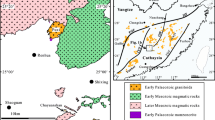Abstract
The discrimination between potential source materials involved in the genesis of Iberian granites and granodiorites, as well as the role of mantle-crust interactions, are examined using constraints imposed by melting experiments, melting-assimilation experiments and Sr-Nd isotope systematics. The Sr-Nd isotope relationships indicate the existence of different genetic trends in which juvenile mantle materials are involved by different mechanisms: (1) a source trend, traced by a particular evolution of the pre-Hercynian basement and indicating mantle participation at the time of sedimentation; (2) a set of magmatic trends traced by gabbro-tonalite-enclave-granodiorite associations, implying the incorporation of new mantle material at the time of granite generation. These relationships strongly support a pure crustal origin for the peraluminous leucogranites, derived from partial melting of crustal protoliths, and a hybrid origin for the peraluminous granodiorites. These granodiorites are the most abundant granitic rocks of the Central Iberian zone (CIZ) of the Iberian massif, implying that processes of hybridisation by assimilation and/or magma mixing played an important role in granitoid production during the Hercynian orogeny. These hypotheses have been tested by means of melting and assimilation experiments. Melting experiments in the range 800–900 °C and at pressures of 3, 6, 10 and 15 kbar indicate that: (1) several potential source materials such as Bt-Ms gneisses and metagreywackes are suitable for the production of peraluminous leucogranite melts; (2) the melt compositions are always leucogranitic, regardless of pressure; (3) pressure exerts a strong influence on the fertility of the source: experiments at 3 kbar produce more than 20 vol% of melt, compared with less than 5 vol% of melt produced at 10 and 15 kbar and at the same temperature. The melting-assimilation experiments carried out at 1000 °C and 4, 7 and 10 kbar and using a proportion of 50% gabbro and 50% gneiss give high melt proportions (more than 50 vol.%) and noritic residues. These melts have the composition of leucogranodiorites, and overlap with part of the compositional range of peraluminous granodiorites of the Iberian massif. The generation of more mafic granodiorites may be explained by the incorporation of some residual orthopyroxene to the granodiorite magmas. The low solubility of Fe + Mg prevents the generation of granodiorite melts with more than 3 wt% of MgO + FeO at all crustal pressures. The large volumes of peraluminous, hybrid granodiorites, produced by assimilation of crustal rocks by mantle magmas, imply that an important episode of crustal growth took place during the Late-Palaeozoic Hercynian orogeny in the Iberian massif.
Similar content being viewed by others
Author information
Authors and Affiliations
Additional information
Received: 30 June 1998 / Accepted: 27 November 1998
Rights and permissions
About this article
Cite this article
Castro, A., Patiño Douce, A., Corretgé, L. et al. Origin of peraluminous granites and granodiorites, Iberian massif, Spain: an experimental test of granite petrogenesis. Contrib Mineral Petrol 135, 255–276 (1999). https://doi.org/10.1007/s004100050511
Issue Date:
DOI: https://doi.org/10.1007/s004100050511




